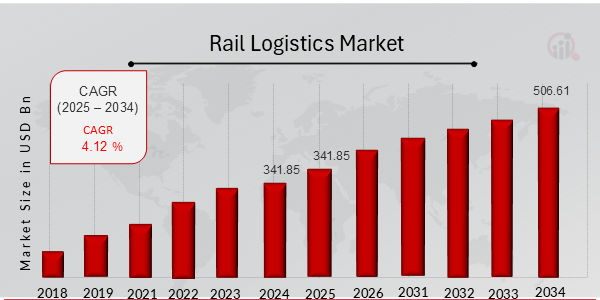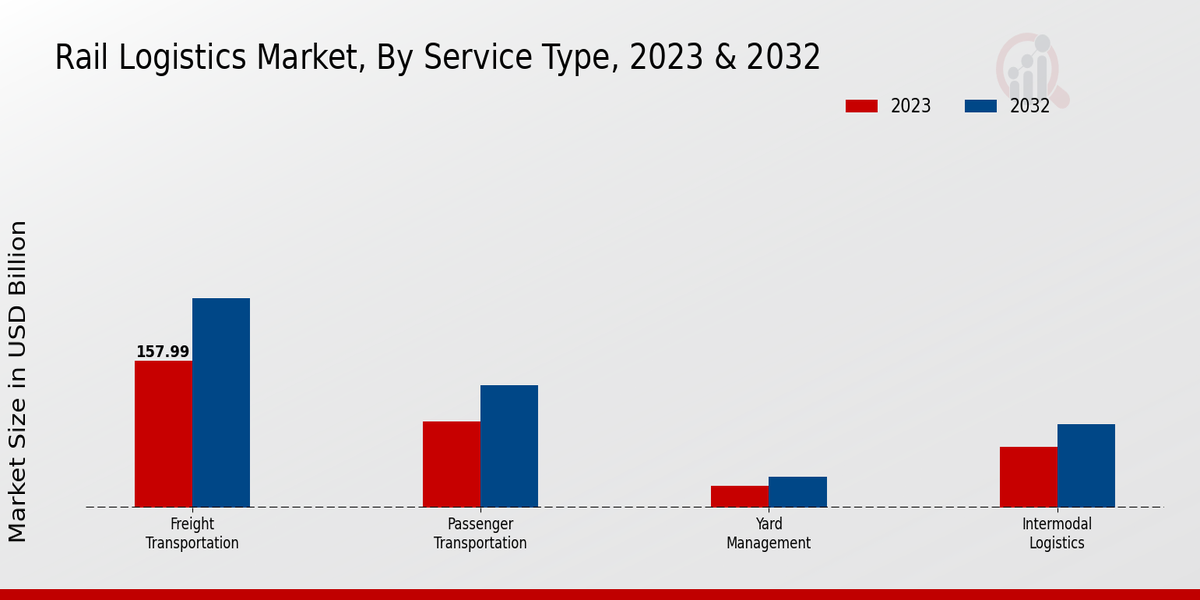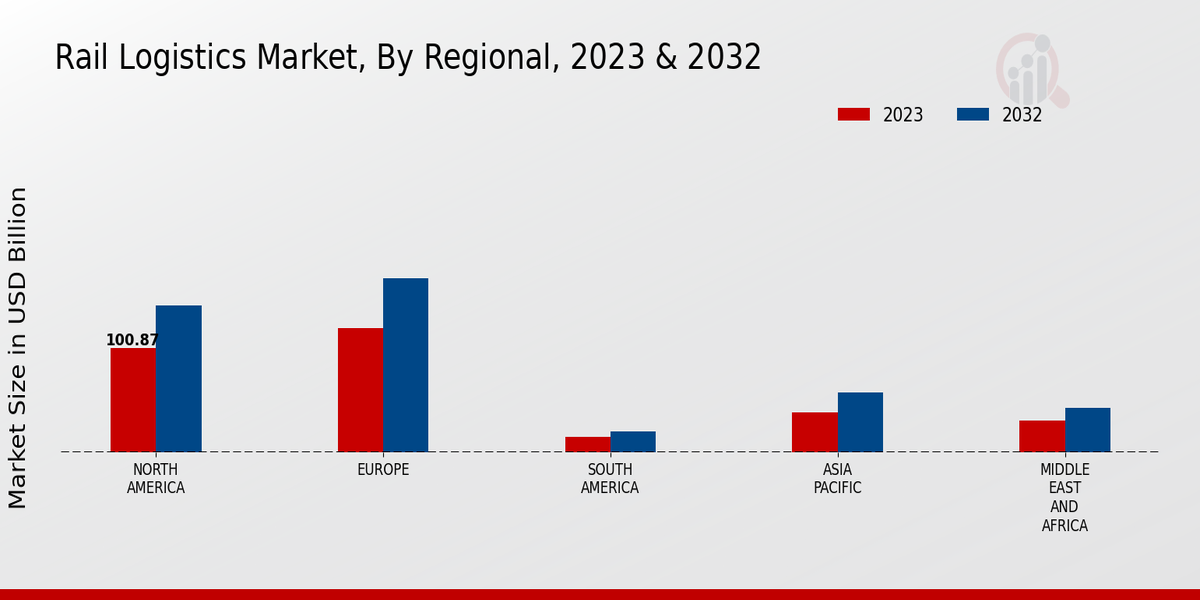Rail Logistics Market Overview
As per MRFR analysis, the Rail Logistics Market Size was estimated at 341.85 (USD Billion) in 2024. The Rail Logistics Market Industry is expected to grow from 355.57 (USD Billion) in 2025 to 506.61 (USD Billion) till 2034, at a CAGR (growth rate) is expected to be around 4.12% during the forecast period (2025 - 2034).
Key Rail Logistics Market Trends Highlighted
Key market drivers in the rail logistics sector include the increasing demand for efficient and sustainable transportation solutions, growing cross-border trade, and government investments in infrastructure development. Opportunities to be explored or captured in the market include the adoption of advanced technologies such as IoT and AI, expansion into emerging markets, and the development of intermodal rail networks. Recent trends in the market include the rise of e-commerce and the consequent increase in demand for last-mile rail transportation, the growing focus on environmental sustainability, and the increasing demand for specialized rail logistics services such as temperature-controlled transportation and hazardous material handling. The market is also seeing increased competition from road and air transportation, driving the need for rail logistics providers to innovate and differentiate their services.

Source: Primary Research, Secondary Research, MRFR Database and Analyst Review
Rail Logistics Market Drivers
Growing Demand for Intermodal Transportation
Rising demand for intermodal transportation is a prominent factor facilitating the Rail Logistics Market Industry’s growth. There are many reasons behind this phenomenon, of which such factors as high fuel costs, growing environmental concerns, and the necessity to make the supply chain more efficient and coherent seem to be the most notable. As a logical part of intermodal transportation, rail delivery, to be precise, serves the purpose of conveying products over long distances, saving costs and using environmentally safe methods.
Expansion of E-commerce and Online Retail
Another key growth driver of this market industry is the rapid development of e-commerce and online retail in general. The rise of online shopping caused a tremendous increase in the volume of shipped goods, which increased the demand for efficient and cheap logistics solutions. The peculiarities of railroad transport make it a very beneficial choice for e-commerce and online retail, such as the ability to ship vast amounts of goods, its reliability, and its cost-effectiveness.Thus, in the upcoming years, the development of e-commerce is expected to continue driving the demand for railroad logistics services.
Increasing Infrastructure Investment
Around the world, both governments and private sector companies invest in rail infrastructure more and more, which can be viewed as another significant growth driver of the Rail Logistics Market Industry. Such a tendency is predetermined by a number of factors, which include the need to increase both transportation efficiency on the whole and economic growth in particular, as well as to alleviate congestion. Thus, in the years to come, the amount of investment in rail infrastructure will grow, offering numerous new opportunities for rail logistics companies.
Rail Logistics Market Segment Insights
Rail Logistics Market Service Type Insights
The division of the Rail Logistics Market by service type brings to light several important insights. The first of these is the tremendous weight of freight transportation, which accounts for the largest share of the market’s revenue. This service includes the movement of various types of products and commodities using rail transportation and is vital to the operation of businesses in a number of sectors, including manufacturing, retail, and agriculture. The key drivers of the growth in this segment are the high demand for cheaper and more efficient systems for moving freight, as well as the rapid expansion of rail infrastructure.Another large segment is the transportation of passengers, which benefits from the increasing popularity of rail travel. As the percentage of the global population that lives in urban areas grows, so does the need for efficient systems of transportation. Additionally, the increasing disposable income of people in developing countries, as well as their ecological awareness, causes them to turn to rail transportation for both short- and long-distance travel. Yard management is another important service as it is crucial to the operations of railroads and the rapid unloading of freight.As railroads become more interconnected and their traffic increases, the importance of efficient systems of coordination and control of yards also grows. Intermodal logistics, which allows the smooth transition of freight from one mode of transportation to another, is another important and growing segment of the rail logistics market. The combination of railroad and maritime or truck transportation is much more cost-effective than placing all freight on the road and rail, and, due to this, it has the potential for rapid growth. As it is necessary for rail and trucking companies to have a high degree of intermodal connectivity, the efficiency of this system will only grow as demand increases.Thus, the division of the rail logistics market by service type generates important insights into the structure and the transformation of this market that companies must take into account.

Source: Primary Research, Secondary Research, MRFR Database and Analyst Review
Rail Logistics Market Infrastructure Type Insights
The Rail Logistics Market is segmented by Infrastructure Type into Track and Signaling, Rolling Stock, Terminals and Depots, and IT and Telecommunications. Among these, the Track and Signaling segment held the largest market share of over 30% in 2023 and is projected to continue its dominance throughout the forecast period. The growth of this segment can be attributed to the increasing need for improved safety and efficiency of rail operations. Governments and railway operators are investing heavily in upgrading and expanding their track and signaling systems to enhance train safety, optimize traffic flow, and reduce delays.The Rolling Stock segment is expected to witness significant growth over the forecast period due to the increasing demand for new and upgraded locomotives, passenger coaches, and freight wagons. The Terminals and Depots segment is also expected to grow steadily, driven by the need for efficient and modern facilities to handle the increasing volume of rail traffic. The IT and Telecommunications segment is expected to grow rapidly, driven by the adoption of advanced technologies such as cloud computing, big data analytics, and the Internet of Things (IoT) to improve operational efficiency and customer service.
Rail Logistics Market End-User Industry Insights
The End-User Industry segment plays a critical role in shaping the Rail Logistics Market. In 2023, the Automotive industry was the largest end-user, accounting for 25% of the market revenue. The Manufacturing industry followed closely, contributing 22% to the market. Other key end-user industries include Agriculture, Mining and Metals, Energy, Chemicals, and Consumer Products. The growth of the Rail Logistics Market is driven by several factors, including the increasing demand for efficient and cost-effective transportation solutions, rising global trade volumes, and government initiatives to promote rail infrastructure development.Key industry participants are focusing on investing in technology, expanding their service offerings, and forming strategic partnerships to gain a competitive edge. The market is also witnessing a trend towards sustainable and environmentally friendly rail logistics solutions.
Rail Logistics Market Application Insights
The Rail Logistics Market is segmented based on Application into Long-Distance Transportation, Short-Distance Transportation, Last-Mile Delivery, and Supply Chain Management. Among these segments, Long-Distance Transportation held the largest market share in 2023 and is expected to maintain its dominance throughout the forecast period. The growth of this segment can be attributed to the increasing demand for efficient and cost-effective transportation of goods over long distances. In 2023, the Long-Distance Transportation segment accounted for approximately 45% of the Rail Logistics Market revenue.Short-Distance Transportation is another significant segment of the Rail Logistics Market. This segment is expected to witness substantial growth over the forecast period due to the rising demand for reliable and timely delivery of goods within short distances. In 2023, the Short-Distance Transportation segment held around 30% of the market share and is projected to grow at a CAGR of 4.5% during the forecast period. Last-Mile Delivery is a growing segment of the Rail Logistics Market. This segment is driven by the increasing popularity of e-commerce and the need for efficient and cost-effective delivery of goods to customers' doorsteps.In 2023, the Last-Mile Delivery segment accounted for approximately 15% of the market share and is expected to grow at a CAGR of 5.0% over the forecast period. Supply Chain Management is another important segment of the Rail Logistics Market. This segment involves the management of the flow of goods and services from suppliers to customers. In 2023, the Supply Chain Management segment held around 10% of the market share and is projected to grow at a CAGR of 4.0% during the forecast period.
Rail Logistics Market Mode of Transportation Insights
The Mode of Transportation segment plays a crucial role in the Rail Logistics Market, with each mode offering unique advantages and catering to specific transportation needs. Conventional Rail remains the dominant mode, accounting for a significant share of the market due to its well-established infrastructure and cost-effectiveness for long-distance bulk transportation. High-Speed Rail has gained prominence in recent years, driven by increasing demand for faster and more efficient passenger transportation, particularly in densely populated areas.Light Rail and Metro Rail systems are primarily used for urban transportation, offering convenient and eco-friendly commuting options with growing adoption in cities worldwide. The Rail Logistics Market is projected to witness steady growth in the coming years, with the increasing demand for efficient and sustainable transportation solutions driving the market expansion.
Rail Logistics Market Regional Insights
The Rail Logistics Market segmentation by region is categorized into North America, Europe, APAC, South America, and MEA. Among these regions, APAC is anticipated to dominate the Rail Logistics Market revenue in the coming years. In 2023, APAC accounted for approximately 38.5% of the Rail Logistics Market share. The growth of the APAC region can be attributed to factors such as the increasing demand for rail freight services and the expansion of rail infrastructure in countries like China and India. Additionally, government initiatives to promote the rail industry, such as the "Make in India" initiative, are further driving the growth of the Rail Logistics Market in the region.

Source: Primary Research, Secondary Research, MRFR Database and Analyst Review
Rail Logistics Market Key Players And Competitive Insights
Major players in the Rail Logistics Market industry are continuously developing new strategies to maintain their competitive edge and expand their market share. Leading Rail Logistics Market players are investing in research and development, acquisitions, and partnerships to stay ahead of the competition and meet the evolving needs of customers. Mergers and acquisitions are becoming increasingly common in the Rail Logistics Market development as companies look to consolidate their position and gain access to new markets and technologies. The competitive landscape of the Rail Logistics Market is expected to remain dynamic over the next few years, with new entrants and established players vying for market share.DB Schenker is a leading provider of rail logistics services worldwide. The company offers a wide range of services, including rail freight, intermodal transportation, and supply chain management. DB Schenker has a strong presence in Europe, Asia, and the Americas and is well-positioned to capitalize on the growing demand for rail logistics services. The company is investing heavily in digitalization and innovation to improve its efficiency and customer service.Union Pacific is one of the largest railroads in North America. The company operates a vast network of rail lines that spans the western United States. Union Pacific offers a variety of rail logistics services, including bulk commodities transportation, intermodal transportation, and automotive logistics. The company is a major player in the Rail Logistics Market and is well-positioned to benefit from the growth of the North American rail market. The company is investing in infrastructure improvements and new technologies to improve its efficiency and service offerings.
Key Companies in the Rail Logistics Market Include
- Watco Companies
- Canadian National Railway
- DP World
- Kansas City Southern
- Aurizon
- Pacific National
- CMA CGM Group
- BNSF Railway
- Genesee Wyoming
- Toll Holdings
- Norfolk Southern Railway
- CSX Transportation
- Asciano
- Union Pacific Railroad
- Deutsche Bahn
Rail Logistics Market Industry Developments
The Rail Logistics Market is anticipated to reach a value of 506.61 billion USD by 2034, expanding at a CAGR of 4.12% from 2025 to 2034. The growing demand for efficient and cost-effective transportation of goods and raw materials is driving market expansion. Government initiatives to promote rail infrastructure development and modernization are further contributing to growth. Asia-Pacific is expected to dominate the market due to its large population and rapid industrialization. Key players in the market include Deutsche Bahn, Union Pacific, and Canadian National Railway. Recent developments include the adoption of advanced technologies such as IoT and AI to enhance operational efficiency and customer service.
Rail Logistics Market Segmentation Insights
- Rail Logistics Market Service Type Outlook
- Freight Transportation
- Passenger Transportation
- Yard Management
- Intermodal Logistics
- Rail Logistics Market Infrastructure Type Outlook
- Track and Signaling
- Rolling Stock
- Terminals and Depots
- IT and Telecommunications
- Rail Logistics Market End-User Industry Outlook
- Automotive
- Manufacturing
- Agriculture
- Mining and Metals
- Energy
- Chemicals
- Consumer Products
- Rail Logistics Market Application Outlook
- Long-Distance Transportation
- Short-Distance Transportation
- Last-Mile Delivery
- Supply Chain Management
- Rail Logistics Market Mode of Transportation Outlook
- Conventional Rail
- High-Speed Rail
- Light Rail
- Metro Rail
| Report Attribute/Metric |
Details |
|
Market Size 2024
|
341.85 (USD Billion)
|
|
Market Size 2025
|
355.57 (USD Billion)
|
|
Market Size 2034
|
506.61 (USD Billion)
|
|
Compound Annual Growth Rate (CAGR)
|
4.12% (2025 - 2034)
|
|
Report Coverage
|
Revenue Forecast, Competitive Landscape, Growth Factors, and Trends
|
|
Base Year
|
2024
|
|
Market Forecast Period
|
2025 - 2034
|
|
Historical Data
|
2019 - 2023
|
| Market Forecast Units |
USD Billion |
| Key Companies Profiled |
Watco Companies, Canadian National Railway, DP World, Kansas City Southern, Aurizon, Pacific National, CMA CGM Group, BNSF Railway, Genesee Wyoming, Toll Holdings, Norfolk Southern Railway, CSX Transportation, Asciano, Union Pacific Railroad, Deutsche Bahn |
| Segments Covered |
Service Type, Infrastructure Type, End-User Industry, Application, Mode of Transportation, Regional |
| Key Market Opportunities |
Economic recovery Ecommerce growth Automation Intermodal transport development Government support |
| Key Market Dynamics |
Increasing demand for efficient and sustainable transportation Upgrading and expansion of rail infrastructure Growing ecommerce and retail sectors Technological advancements and digitization |
| Countries Covered |
North America, Europe, APAC, South America, MEA |
Frequently Asked Questions (FAQ) :
The Rail Logistics Market is projected to be valued at approximately USD 355.57 billion in 2025.
The Rail Logistics Market is anticipated to grow at a CAGR of 4.12% from 2025 to 2034.
The Asia-Pacific Rail Logistics Market was valued at approximately USD 120 billion in 2023.
The Asia-Pacific region is projected to dominate the Rail Logistics Market with the largest market share by 2032.
Rail logistics is utilized for the transportation of various goods, including bulk commodities, finished goods, and raw materials.
Major players in the Rail Logistics Market include companies like Deutsche Bahn AG, Union Pacific Corporation, and CSX Corporation.
The European Rail Logistics Market is projected to reach approximately USD 150 billion by 2032.
The intermodal segment is anticipated to be a significant driver of growth in the Rail Logistics Market.
The Rail Logistics Market is projected to reach approximately USD 450 billion by 2032.
The growing demand for efficient and cost-effective transportation solutions is a key factor driving the growth of the Rail Logistics Market.

















